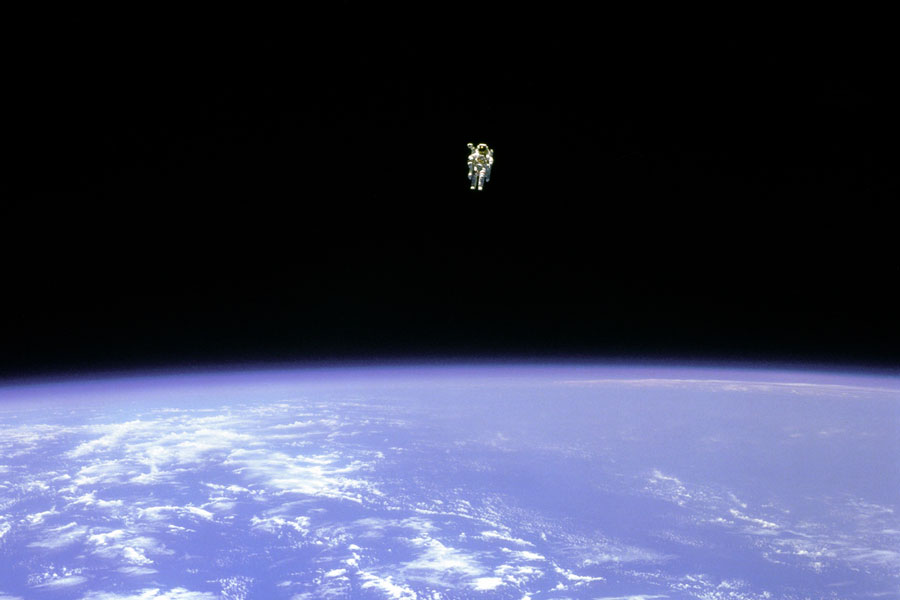Spaceship Earth?
This post contributed by Liza Lester, ESA communications officer

Astronaut Bruce McCandless II drifts free, 350 kilometers above Earth’s surface and 100 meters from the safe haven of the Space Shuttle Challenger, during one of NASA’s first un-tethered spacewalks (credit, STS-41B, NASA 1984, via the Astronomy Picture of the Day). Invisible bonds of absolute necessity hold the free-flying astronaut to his shuttle, and to Earth below. He can take a short walk in space, but he is sightseeing on borrowed time. Earth has a monopoly on all the necessities of life.
When the space programs of the ‘60s began sending back images of a small, blue jewel suspended in the vast darkness of space, the metaphor of the Earth itself as a spaceship came easily into public discourse. Modern economics also leant power to the notion of the Earth as a single, global system. Humans had begun to appreciate the scale of change that our technology had wrought. Abruptly, we found ourselves fellow passengers on a lonely vessel, our fortunes tied together.
Barring radical reformation of our conception of physics, colonization of other planets is not practical or practicable even as a small-scale curiosity, much less an escape plan. The good ship Earth is our only ship, so we had best not sink it. In Tuesday’s Washington Post, Joel Achenbach reports on a movement toward a new paradigm of management and intervention in environmentalism, a Spaceship Earth on which we are not just passengers, but engineers.
Just what sinking Earth would entail is a matter of debate. The idea that it would even be possible to sink it is rather new. For a substantial US voting bloc, the world is still a garden for us to harvest, and its upkeep and management is not our business. At passionate odds with the champions of this resource Manifest Destiny, environmentalists object morally to the loss of wilderness, the present wave of extinctions, and the invasion of the successful, surviving species into exotic new locations with the help of human transport. To the less ideologically committed folks in the middle, keeping Earth afloat is synonymous with keeping their own lives and lifestyles afloat, leavened with some empathy for distant communities and future generations. So conservation traditionally operates under a paradigm of custodianship, protection, and restoration.
To what perfect historical time do wish to restore our pockets of wildlands? ask the proponents of the new school. Though our current numbers and technological reach are tremendous, humans have been manipulating our environs for thousands of years. There is no pristine Before which can be restored, say the interventionists. The great grasslands of North America were not untouched by man before Europeans usurped them, and converted them to corn and wheat and cattle. The people that preceded them burned the prairies and hunted the prairie animals, points out nature writer Emma Marris. We are part of the system. We make a choice to restore prairie reserves in the image of the seventeenth century, but we cannot know what the prairies would look like if humans did not exist. We could make different conservation choices. We could accept or even protect exotic species, and manage new ecosystems as they coalesce under pressure of human-generated changes to the physical environment.
At the more extreme (or exuberant, depending on your point of view) end of the interventionist spectrum, the geoengineers want to fix our climate problem with cloud seeding and ocean fertilization and other massive chemical and physical experiments. Stewart Brand, famous for the late ’60s-era “Whole Earth Catalog,” supports genetic engineering and nuclear power in the pursuit of environmental vitality. The range of intervention Achenbach covers in his story links a diversity of opinionated individuals who would probably not agree to such casual lumping.
All of these people will tell you that they are optimists. The proactive drive of the management paradigm is a big element of its appeal. If you must expend a lot of effort and tax dollars on a communal problem, it’s more exciting build something, do something. To mobilize and coordinate in order to not do something lacks entrepreneurial vigor and can-do spirit, and is always an imposition, which no one likes when applied to one’s self. Regulations are frustrating and irritating, and it isn’t pleasant to be made to feel guilty about use of resources and economic aspirations. It chafes like a paternalistic scold.
Geoengineering beguiles economists with its appealingly masculine machine metaphors and assertive action plans. But the problem with the engineering route is that we didn’t build the machine, if the Earth is a machine, and we don’t have the blueprints. Any global intervention is an uncontrolled (in both senses of the term) experiment. The metaphor of a machine implies a static, designed system. Biological systems adapt.
Some (Emma Marris, Lisa Naughton-Treves) in Achenbach’s new wave prefer the old garden metaphor for natural (and political and economic) systems over the deterministic clockwork of the spaceship. But this time, we are the gardeners.